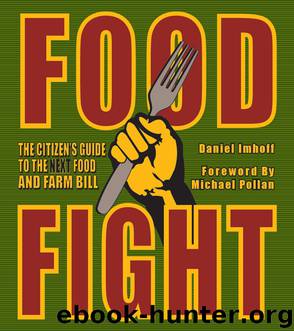Food Fight by Imhoff Daniel Pollan Michael Kirschenmann Fred

Author:Imhoff, Daniel, Pollan, Michael, Kirschenmann, Fred
Language: eng
Format: epub
ISBN: 9780984630400
Publisher: Watershed Media
Figure 22
Source: USDA’s MyPlate Homepage; “Agriculture and Health Policies in Conflict: How Food Subsidies Tax Our Health,” Physicians Committee for Responsible Medicine.
From Hunger to Health—The 21st Century Safety Net
The Farm Bill’s Nutrition Title has grown from an effort to distribute surplus crops during the Great Depression, into the largest food assistance program in the country. For more than 45 million people, or 1 out of 7 Americans in 2011, the Supplemental Nutrition Assistance Program (SNAP) often meant the difference between going to bed hungry and receiving minimal nourishment. Food stamps (SNAP), Women, Infants, and Children’s (WIC) vouchers, and free and subsidized school meals all enhance the well-being of low-income Americans. To its great credit, the antihunger lobby has heroically defended the country’s hunger safety net in Farm Bill after Farm Bill, attaining the necessary votes to “do no harm” to food assistance programs that essentially counter an entrenched national commitment to low minimum wages. The antihunger lobby has also worked to de-stigmatize food assistance. An innovative debit card style system (Electronic Benefits Transfer, EBT) has replaced paper coupons and can even be used in approximately 10 percent of the country’s 7,000 farmers’ markets.
The biggest challenge may be that the Thrifty Food Plan, which sets the SNAP Program’s upper cap for monthly benefits at $1.40 per person per meal, does not provide recipients with enough money to eat a balanced healthy diet. Likewise, the working poor disproportionately rely on foods that are loaded with sugars, sodium, and saturated fats. This is not necessarily out of dietary preference as much as the economic pressures that many Americans face. The easiest-to-prepare products in supermarket aisles often turn out to be those that are mass produced and made from heavily subsidized crops: frozen prepared foods, dairy products, baked goods. According to Adam Drenowski, professor of epidemiology at the University of Washington, the poor in particular are gaining weight and getting sick because unhealthy food is cheaper and often more available than healthy food.16
Admirable efforts were made in the 2008 Farm Bill to shift the mission of nutrition programs from simple hunger relief to making healthier foods available to the public. The Farmers Market Promotion Program set aside at least 10 percent of its funds to put SNAP benefit EBT machines in markets. The Senior Farmers Market Nutrition Program offered coupons for fruits and vegetables, honey and fresh herbs. A SNAP-Ed program dedicated $1 billion for promoting and better understanding healthy eating behavior among food stamp recipients. Healthy Incentives Pilot programs were set up to determine whether out-reach campaigns actually encouraged greater consumption of fruits and vegetables. The Fresh Fruit and Vegetable Program funded an increase in the volume of healthy snacks in public schools.
In upcoming Farm Bills, legislators must find ways to realign crop subsidies. Public health demands more federal attention to nutrient-rich foods and less to feed crops and commodities. The good news is that this can be a very powerful job-creating opportunity—engaging young farmers, creating regional food hubs, bringing up a new generation of chefs and food entrepreneurs.
Download
This site does not store any files on its server. We only index and link to content provided by other sites. Please contact the content providers to delete copyright contents if any and email us, we'll remove relevant links or contents immediately.
| Anthropology | Archaeology |
| Philosophy | Politics & Government |
| Social Sciences | Sociology |
| Women's Studies |
The Secret History by Donna Tartt(18147)
The Social Justice Warrior Handbook by Lisa De Pasquale(11950)
Thirteen Reasons Why by Jay Asher(8447)
This Is How You Lose Her by Junot Diaz(6430)
Weapons of Math Destruction by Cathy O'Neil(5824)
Zero to One by Peter Thiel(5487)
Beartown by Fredrik Backman(5348)
The Myth of the Strong Leader by Archie Brown(5236)
The Fire Next Time by James Baldwin(5015)
How Democracies Die by Steven Levitsky & Daniel Ziblatt(4950)
Promise Me, Dad by Joe Biden(4907)
Stone's Rules by Roger Stone(4852)
100 Deadly Skills by Clint Emerson(4683)
A Higher Loyalty: Truth, Lies, and Leadership by James Comey(4546)
Rise and Kill First by Ronen Bergman(4542)
Secrecy World by Jake Bernstein(4387)
The David Icke Guide to the Global Conspiracy (and how to end it) by David Icke(4376)
The Farm by Tom Rob Smith(4320)
The Doomsday Machine by Daniel Ellsberg(4241)
